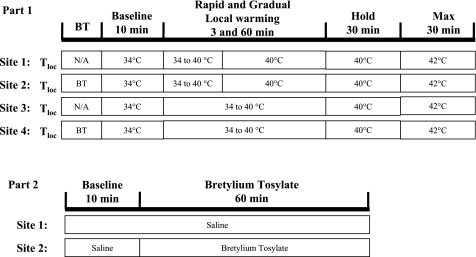Fig. 1.
Protocols. Part 1 (top) was designed to test for a role of the rate of local heating. Using 4 skin sites, 2 pretreated with bretylium tosylate (BT) via iontophoresis (sites 2 and 4) and 2 untreated (sites 1 and 3) are shown. Local heating raised local temperature (Tloc) from 34° to 40°C rapidly (+2°C/min; sites 1 and 2) or slowly (+0.1°C/min; sites 3 and 4). After local heating was completed, Tloc was maintained at 40°C until experiment time 100 min. Tloc was then increased to 42°C for 30 min to obtain maximal skin blood flow. In part 2 (bottom), we sought to determine whether, at whole body skin temperature of 34°C, there was any tonic cutaneous vasoconstrictor nerve activity. At 2 skin sites, microdialysis fibers were perfused with saline for 10 min. The infusion at site 2 was changed to BT (10 mM) for a further 60 min. An increase in cutaneous vascular conductance (CVC) in response to the infusion of BT would indicate the existence of tonic vasoconstrictor activity. Max, maximum; N/A, not applicable.

